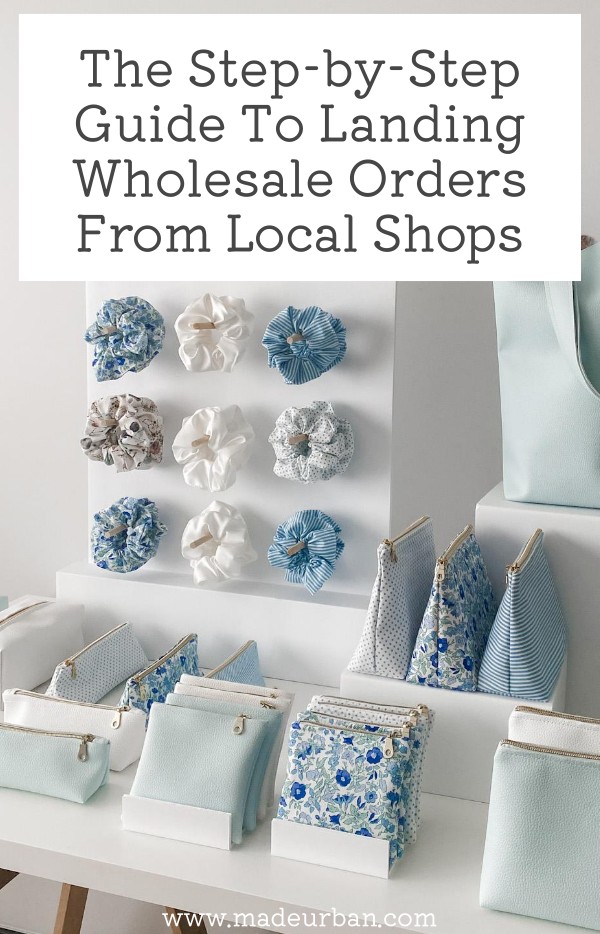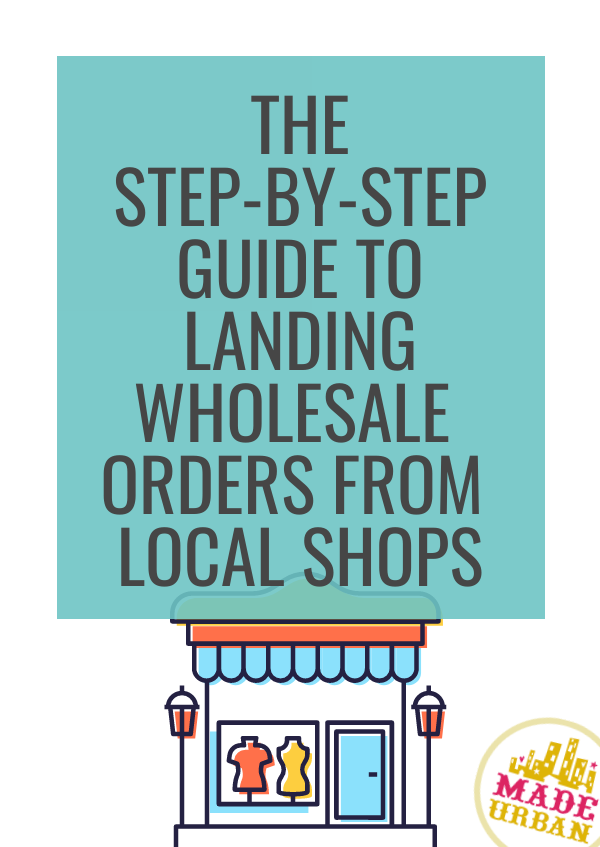The Step-by-Step Guide to Landing Wholesale Orders from Local Shops
Once you’ve set your business up for selling wholesale, you can start approaching retailers and pitching your products.
I hesitated longer than I should because I didn’t know where to start.
- Who should I contact?
- Who do I ask to speak to?
- What should I say to them?
This article will walk you through the process so you can land more wholesale accounts with local shops.

Step 1 – Find local shops
The key to gaining and keeping wholesale accounts is to work with the right shops.
If you manage to get your products into a retailer that’s NOT a great fit for your products, your products won’t sell, they won’t re-order, and it could harm your brand’s reputation in the small local community.
Start close to home. You likely know the boutiques in your area; create a list of all the shops you know and love.
You can also use Google Maps to find boutiques in different areas of the city.
Another sneaky method is to spy on your competitors. Use “competitors” with whom you’re not in direct competition.
For example, I would look at other local bag businesses that have a different style than mine. Or, I would look at local businesses that share a similar style, but sell a different product.
Then check out those “competitors'” websites to see if they have a “Where to Buy” page that lists the retailers that carry their products.
These will be good stores for you to approach as well.
Step 2 – Gather information
Next, you’ll gather information to help you narrow down your list to shops that are the best fit for your products.
You can stop in the shop or visit their website and social media pages to gather information such as:
- Their brand and target market – do they align with yours?
- Price points – will your product’s prices be a fit in their store?
- Display space – how might they display your products? If they’re a tiny boutique and your products are oversized, it may not be a good fit.
- Competitors – do they already carry your competitor’s products? If your products aren’t too similar, it’s a good indication that they may also be interested in your products. If your products are really similar to your competitors, you may want to skip this store.
This information will help you determine if you’ll make a good pairing, and will help you show the retailer that you’re familiar with their business if you do decide to reach out.
Step 3 – Choose the RIGHT shops
With the information gathered, choose 1 – 3 shops to reach out to first.
You can select more than 3, just be sure you’ll be able to fulfill orders if every shop you contact decides to place an order.
Start with shops that are the best fit for your products and give them a good chance of selling.
Then make sure you’re selecting stores that aren’t too close in proximity.
Each retailer wants to offer unique products. So they won’t love if you’ve sold the same products to a shop on the same street.
Once you have your list, find out who the right person to contact is.
Look for contact information on their website or social media account. You’re looking for the owner, buyer, or even the store manager. In a smaller boutique, the owner may be the buyer and store manager.
You can also call, during hours you know aren’t peak shopping times, to introduce yourself, find out who’s responsible for buying, and the best method for you to send your business’s information over.
Step 4 – Reach out
It’s NOT a good idea to just pop in with your information. They’re trying to make sales when their store is open, and they don’t want to be distracted.
If you happen to be in a store and chatting with the owner when it’s not busy, you can mention your business and that you think your products would be a good fit, then ask for their information to contact them later. But be mindful of their time.
Most retailers will appreciate an email that they can look over in their own time. Which might read:
Hi _______ (owner’s/buyers/store manager’s name),
I’m _____ and I have a local handmade business called _____.
My business offers _____ (your USP; what makes your products/business unique).
(You can insert a photograph of your products to entice them to open your line sheet attachment)
I think my products would be a good fit in your store because ______ (we both target a similar market (e.g. expecting moms or eco-conscious shoppers), our brands align, etc.). (Don’t go overboard here, but show them you’re familiar with their business and give valid reasons why you believe your products would be profitable for them).
Attached is my lookbook/line sheet, and I’ll reach out in a few days to see if you have any questions, or you can reply to this email.
(Your line sheet should include all the information they need to make a purchasing decision and direct them on how to place an order.)
(If you sell something like bath and body products, you may also suggest that they reply to the email to let you know if you can send a few samples over.)
Thank you for taking the time to look over my products.
Name
(contact information)
Step 5 – Follow Up
Hopefully, the buyer/store owner will reply to your email and want to place an order.
But if you haven’t heard back in a week or two, reach out to follow up.
Keep it simple and to the point.
It might read:
Hi _____,
I’m just following up to see if you had any questions about my product line (line sheet attached if you missed my email last week).
No worries if it’s not a fit right now, but please don’t hesitate to get in contact if you’d like to place an order, or if you have any feedback for me.
Thank you for your time,
Name
Contact information
Step 6 – Be prepared for no response
Don’t take it personally if you don’t get a response from a retailer. Especially if it’s one you’ve had no prior contact with, it’s a bigger retailer, or they’re in another city.
Retailers get a lot of pitches from businesses just like yours, so they often don’t have time to respond to all of them.
When you target retailers that really are a great fit for your products and spend a bit of time building a relationship with them, you’re more likely to get a response.
But if you don’t, it’s okay. Just keep working through your list.
Step 7 – Nurture your relationships
When you do get a retailer who wants to place an order, be sure to fulfill your promises and deliver on time.
Then check in with them to make sure they’re happy with your product and inquire about re-orders.
If the retailer is in your city and it makes sense to do so (cost-wise), you can drop orders off in person, so you get to know the owner and staff.
Building this relationship can make them feel more connected to your product, making it easier for them to market and sell it. They’ll also be more likely to offer helpful feedback and re-order when they feel connected to your business.
Landing local wholesale accounts isn’t about luck — it’s about preparation, professionalism, and persistence.
When you take it step-by-step, you’ll build relationships with stores that genuinely want to stock your products.
Start local, stay consistent, and those wholesale orders will come.
If all of this sounds like too much, you can also outsource it.
There are companies that will:
- Create lookbooks and line sheets for your business
- Make retailer connections (e.g. Faire)
- You may even be able to find someone who will reach out to retailers on your behalf (and take a commission of any wholesale orders)


Hey, I’m Erin 🙂 I write about small business and craft show techniques I’ve learned from being a small business owner for almost 2 decades, selling at dozens of craft shows, and earning a diploma in Visual Communication Design. I hope you find my advice helpful!
